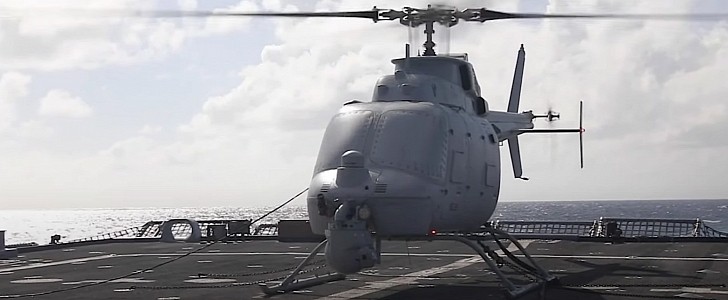Back at the beginning of March, we learned of a new capability on the verge of being added to the MQ-8C Fire Scout: mine detection. Fast forward a couple of months, and the U.S. Navy says it’s about ready to give the new hardware a go.
Called Single System Multi-Mission Airborne Mine Detection (SMAMD) and being developed by BAE Systems, the hardware is nothing more than an airborne optical sensor suite, but one that is crucially different than current mine-detection technologies.
Unlike what’s currently in use, which requires post-mission analysis to spot the dangerous munitions, the BAE SMAMD will be real-time and promises to bring low false-alarm rates.
The thing was never actually put to the test until now, but the Navy did fly mass equivalency models on the Fire Scout back in February. That’s because the SMAMD will be the drone’s heaviest payload to date, and engineers wanted to make sure it can be carried.
This week, the U.S. Navy announced it is getting ready for the final phase of the program, with actual land-based testing of the system to take place at the Naval Surface Warfare Center in Panama City, Florida.
There, the Fire Scout will have to move over the beach in search of drifting and moored mines, and it will have to do so in both shallow and deep water. The helicopter will have to cover an area that extends to up to 10 km (6.2 miles) from the shore.
“This capability is extremely important as we see future fights occurring in the littoral waters where mine warfare is prevalent,” said in a statement Capt. Thomas Lansley, Fire Scout program director. “A mine warfare capability will greatly reduce risk for littoral combat ships.”
Based on the Bell 407 helicopter, the Fire Scout’s main mission is intelligence, surveillance, reconnaissance (ISR), but can also be used for target-acquisition operations. It can be deployed either from land, or from ships, and can stay airborne for up to eight hours.
Unlike what’s currently in use, which requires post-mission analysis to spot the dangerous munitions, the BAE SMAMD will be real-time and promises to bring low false-alarm rates.
The thing was never actually put to the test until now, but the Navy did fly mass equivalency models on the Fire Scout back in February. That’s because the SMAMD will be the drone’s heaviest payload to date, and engineers wanted to make sure it can be carried.
This week, the U.S. Navy announced it is getting ready for the final phase of the program, with actual land-based testing of the system to take place at the Naval Surface Warfare Center in Panama City, Florida.
There, the Fire Scout will have to move over the beach in search of drifting and moored mines, and it will have to do so in both shallow and deep water. The helicopter will have to cover an area that extends to up to 10 km (6.2 miles) from the shore.
“This capability is extremely important as we see future fights occurring in the littoral waters where mine warfare is prevalent,” said in a statement Capt. Thomas Lansley, Fire Scout program director. “A mine warfare capability will greatly reduce risk for littoral combat ships.”
Based on the Bell 407 helicopter, the Fire Scout’s main mission is intelligence, surveillance, reconnaissance (ISR), but can also be used for target-acquisition operations. It can be deployed either from land, or from ships, and can stay airborne for up to eight hours.







